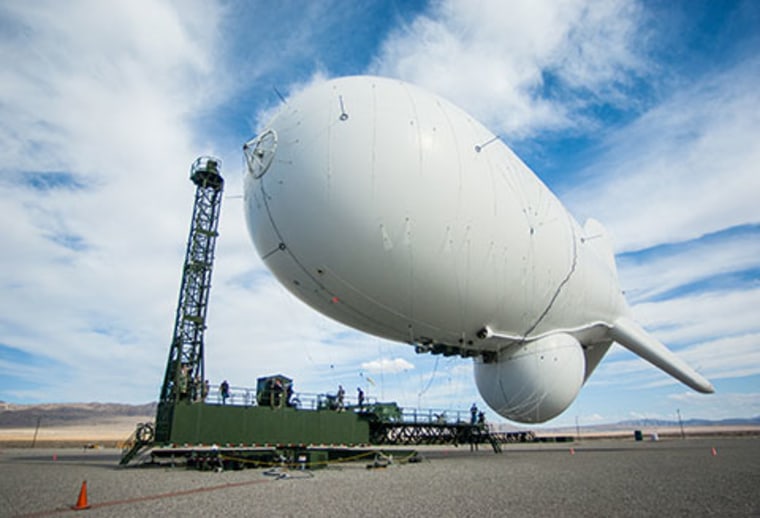The runaway Army surveillance blimp that drifted over Pennsylvania on Wednesday — twice as big as the biggest whale and dragging an inch-thick Kevlar cable behind it — is really hard to bring down, and authorities remain mystified not only as to why it broke free, but also as to why it landed on its own.
Related: Military Blimp on the Ground in Pennsylvania: NORAD
First things first. The contraption — one of two tethered airships that make up the inconveniently named Joint Land Attack Cruise Missile Defense Elevated Netted Sensor System, or JLENS — isn't really a blimp, according to its manufacturer, Raytheon Integrated Defense Systems of Waltham, Massachusetts.
It's an "aerostat" filled with helium. As the name implies, it's designed to detect and track cruise missiles and other aircraft from up to 340 miles away. It's totally run from the ground — there's no one aboard it.
Some other interesting things to know about JLENS (which the military pronounces "JAY-lens"):
It's enormous
The largest known mammal is the blue whale, which typically grows to 110 feet long. A JLENS aerostat is 243 feet long. Raytheon says it has to be that huge to support its powerful radar system, which is designed to monitor an area the size of Texas.
It's not armed
The blimp isn't JLENS — JLENS is two blimps. One blimp carries surveillance radar, and the other carries a separate targeting radar in case something needs to be shot down. The actual shooting would be done by any of several other weapons systems that JLENS can integrate with.
When they're up in the air and operating, they're said to be in an "orbit," even though they're not really in orbit.
It has staying power
Raytheon says the JLENS system can remain aloft and operational for 30 days, providing the same round-the-clock monitoring as five fixed-wing surveillance aircraft, for one-fifth to one-seventh the cost.
It's hard to bring down
You can't just stick a pin in a JLENS blimp and pop it. At optimal altitude of 10,000 feet, the internal pressure of the helium is about the same as that of the outside atmosphere — so even if you were to puncture it with thousands of holes, the helium would leak out slowly.

Raytheon says it would take several days for a blimp to gently settle to the ground even if an enemy strafed it — which is why there's a built-in mechanism for operators to remotely dump its 590,000 cubic feet of air and non-flammable helium from the ground.
But the North American Aerospace Defense Command (NORAD), which scrambled jets to track the blimp as it meandered away, told NBC News that it didn't deflate the blimp from the ground. Its own auto-deflation system could have kicked in, but no one knows for sure yet.
The tether is more than a tether
The mile-long tether that's supposed to anchor the blimps to the ground is made of 1-inch-plus-thick super-strong Kevlar.

It's supposed to be strong enough to withstand 100-mph winds, Raytheon says. But winds at Aberdeen Proving Ground, Maryland, where the system is based, were in the single digits Wednesday, leaving the blimp's escape a mystery for now.
The tether does more than just anchor the blimp. It's stuffed with electric cables powering the radar systems and with fiber-optic wires ferrying data to and from computers on the ground.
It's controversial
The Defense Department's own testers have raised doubts about JLENS. A 2013 assessment by the Office of Operational Test and Evaluation (PDF), the most recent available, found that "system-level reliability is not meeting program growth goals" and that "the system does not meet the requirements for Operational Availability, Mean Time to Repair, or Mean Time Between System Abort."
"Both software and hardware reliability problems contribute to low system reliability and availability," according to the assessment.
Outside critics have also opposed it on privacy grounds.
In January 2013, Raytheon said it successfully tested a potential system to "observe surface moving targets" — that is, people on the ground, like a terrorist planting an improvised explosive device — in real time.
Amid objections from privacy advocates, the Army last year promised that it wouldn't put cameras on JLENS systems.
But the documents in which the Army made that promise were so heavily redacted that groups like the nonprofit Electronic Privacy Information Center, based in Washington, say there was no guarantee it wouldn't add cameras in the future.
EPIC has sued to force the government to reveal how the Army plans to process, store, redact or delete data.

